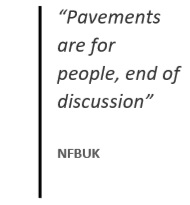
Image: Highways England via Flickr
Government plans to make pavements the ‘default location’ for new utilities’ infrastructure have been criticised by pedestrian and disability campaign groups.
Speaking to The Times, Chris Grayling said the move would cut congestion and reduce the number of potholes of UK roads.
The transport secretary explained that potholes are far more likely to appear on sections of roads that have been recently dug up.
Mr Grayling added that companies would not be allowed to dig up pavements on both sides of road at the same time, to ensure that pedestrian routes were retained where possible.
 However, the plans have been heavily criticised, with a number of campaign groups expressing concern over potential safety implications.
However, the plans have been heavily criticised, with a number of campaign groups expressing concern over potential safety implications.
Stephen Joseph, chief executive of the Campaign for Better Transport, told The Times: “Pavements are already in a terrible state, partly because we already have lots of utilities under there.
“The result is that the NHS spends an awful lot of money treating people who’ve had trips, slips and falls on uneven and badly maintained pavements.
“Unless Chris Grayling is prepared to make much more money available for pavements, he will simply make an already big problem a whole lot worse. You can’t just export the problem from roads to pavements without expecting major consequences.”
A spokesperson for the National Federation of the Blind of the UK said: “If Chris Grayling thinks he is going to disrupt access for blind and disabled people simply to grab a quick headline rather than address underlying issues around efficiency, proper road maintenance and collaboration within the roads sector, he is going to have one hell of an fight on his hands.
“Pavements are for people, end of discussion.”
David Davies, executive director of the Parliamentary Advisory Council for Transport Safety (PACTS), said: “The proposal to relocate services from the road to the pavement needs to be closely scrutinised for the implications for pedestrian safety.
“Cycleways, too, are likely to be affected. It is vital that savings in road maintenance do not become costs to the NHS and social care.”
A spokesperson for the DfT told Transport Network that Mr Grayling’s announcement was not an official Government announcement – and that it was unable to comment because of Purdah restrictions in advance of local government elections.
I know what he says when it will reduce the potholes created by other poor works but unfortunately we are suffering now and will be suffering for a number of years to come. Possibly a decade of poor roads. Potholes in my mind are due to the increased burden that normal streets suffer and were never meant to bear. On a motorway its different from the more fragile roads found within a town. On a motorway there are many more HGV’s but the roads are made to take their weight, they don’t stop and start at junctions. They rarely accelerate and brake hard and there are no severe corners or bends that would make a HGV push or pull the tarmac’s surface skin. A skin that can be fractured and that eventually allows water in which eventually causes the break up of the surface and sometimes a pothole.
Maybe we should reduce the number of 40 ton plus and 50 ft long HGVs delivering in towns and causing this damage. Maybe we should have out of town depots where a day’s deliveries could be loaded onto smaller vehicles.
R. Craven
+1
Good, put them in the pavement ASAP.
You cannot continue with a failed policy of installing metal access covers in the road, especially at junctions and on bends providing a designed-in hazard to motorcyclists, our statistically most vulnerable road user group. These utility service covers are lethally slippery in the wet so design them out.
Pat, Wales
--5
The vast majority of our utility supply cables and pipes are, and always have been, under the footways anyway aren’t they? I can only think of sewers and the larger gas and water main distribution pipes that normally have to go under the c/way.
Hugh Jones
+2